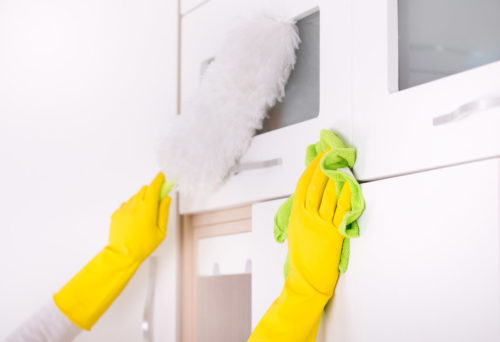According to the American Hardwood Council, confusion is fueled by the myth that wood is “alive” and needs to breathe. On the contrary, according to the council’s information center, wood doesn’t need to be “moisturized” with oily cleaners and polishes. If wood dries and cracks it’s due to changes in humidity, not for lack of oil.
Basic Kitchen Care Tips
Kitchen care is simple, fast and requires no dangerous chemicals or treatments. Practice these basic care tips, and enjoy the look of your timeless cabinetry for years to come.
- Wipe up spills, splatters and water spots as they occur – keep the cabinets dry.
- Clean as needed with a soft, lint free cloth. Use a mild detergent or soap and warm water.
- Dry surfaces immediately with a soft cloth.
- Avoid using a dishcloth or sponge – it could contain remnants of grease or detergents.
- Do not use products with bleach, ammonia or abrasive additives.
- Never use scouring pads, steel wool or powdered cleaners.
- Do not allow oven cleaners to come in contact with wood finishes.
- Avoid placing small kitchen appliances where heat is directed onto cabinet surfaces.
- Avoid draping damp cloths or dishtowels over cabinet doors – excessive moisture can cause permanent damage.
- Do not use waxes or polishes.
Caring for Wood and Laminates
Basic care techniques, when employed regularly, prevent damage and assure years of beautiful, functional use. You’ve taken the time and the resources to invest in classic, high quality cabinetry – why shorten its lifespan with neglect or misuse?
There are several important differences to note when caring for solid wood cabinetry versus laminate cabinetry. If you have recently upgraded to custom made wood cabinetry, it’s especially important to note these differences, as care techniques common to laminates will damage the rich patina that solid wood provides.
- Using a low-abrasive brush or clean sponge on laminate cabinetry is a common way to remove stains. Never use an abrasive tool on solid wood cabinetry – even a soft brush will scratch and damage solid wood.
- Never use an abrasive cleanser such as baking soda or detergent on solid wood cabinetry. Plain or soapy water – provided the soapy water contains a gentle cleanser – is best.
- Removing stains from laminate cabinetry sometimes calls for all-purpose cleansers. Using an all-purpose cleanser on solid wood cabinetry may remove the finish and damage the wood.

Cabinet Hardware Installation and Adjustments
A common question we receive is how to adjust sliding drawer hardware. Click here for that information.
Another question we commonly receive is how to install and adjust cabinet hinge hardware. Click here to learn how.
#KountryKraft #Cleaning #Care
